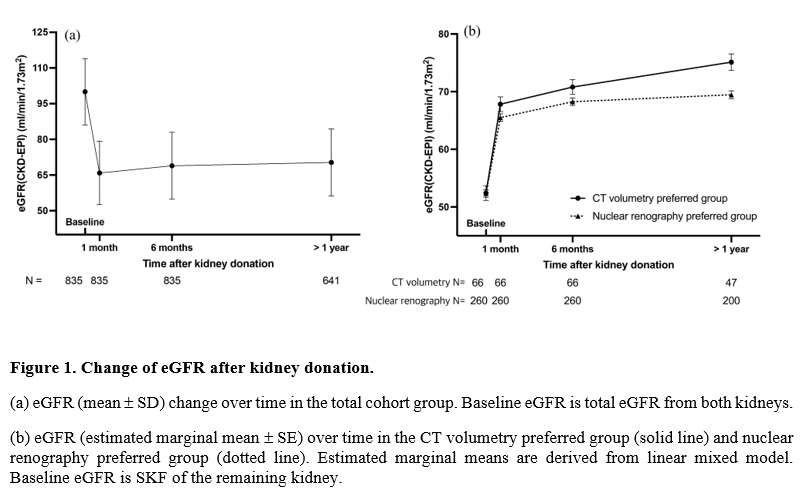Comparison of CT Volumetry versus Nuclear Renography for Predicting Remaining Kidney Function After Uninephrectomy in Living Kidney Donors
1Division of Nephrology, Department of Internal Medicine, Seoul St. Mary's Hospital, Seoul, Korea, Republic of, 2Department of Urology, Seoul St. Mary's Hospital, Seoul, Korea, Republic of, 3Division of Nephrology, Department of Internal Medicine, Incheon St. Mary's Hospital, Incheon, Korea, Republic of
Meeting: 2022 American Transplant Congress
Abstract number: 1718
Keywords: Donation, Kidney transplantation, Nephrectomy, Prognosis
Topic: Clinical Science » Kidney » 42 - Kidney Living Donor: Selection
Session Information
Session Name: Kidney Living Donor: Selection
Session Type: Poster Abstract
Date: Tuesday, June 7, 2022
Session Time: 7:00pm-8:00pm
 Presentation Time: 7:00pm-8:00pm
Presentation Time: 7:00pm-8:00pm
Location: Hynes Halls C & D
*Purpose: Computed tomography (CT) and nuclear renography are used to determine kidney procurement strategy in living kidney donors (LKDs). The present study investigated which modality better predicts kidney function after donation, especially in cases of discordance.
*Methods: The study included 835 LKDs who underwent CT volumetry and nuclear renography. LKDs were divided into two subgroups based on whether the left-right dominance of kidney volume was concordant with kidney function (concordant group) or not (discordant group). The predictive value for post-donation kidney function was compared at 1 month, 6 months, and > 1 year in total cohort, concordant, and discordant groups between the two imaging techniques.
*Results: Mean age at kidney donation was 43.76 ± 12.07 years and 56.41% of the donors were female. Average eGFR was 100.01 ± 13.94 mL/min/1.73 m2 and measured glomerular filtration rate (mGFR) was 107.16 ± 17.39 mL/min. Total kidney volume, measured glomerular filtration rate (mGFR), and estimated GFR (eGFR) at baseline were significantly correlated. CT volumetry and nuclear renography showed significant correlation with good agreement for estimating split kidney function (SKF) (ICC = 0.647, 95% CI 0.596 – 0.692, P < 0.001). In addition, SKF measured using both methods significantly correlated with eGFR after donation in the total cohort group and two subgroups (concordant and discordant). In multivariable analyses, CT volumetry was superior to nuclear renography for predicting post-donation kidney function in the total cohort group and both subgroups. In the discordant subgroup, a higher tendency of kidney function recovery was observed when kidney procurement was determined based on CT volumetry results.
*Conclusions: CT volumetry outperformed nuclear renography for predicting kidney function after donation. Therefore, CT volumetry is preferred when determining procurement strategy especially when discordance is found between the two modalities.
To cite this abstract in AMA style:
Eum S, Lee H, Ko E, Cho H, Yoon H, Shin S, Yang C, Chung B. Comparison of CT Volumetry versus Nuclear Renography for Predicting Remaining Kidney Function After Uninephrectomy in Living Kidney Donors [abstract]. Am J Transplant. 2022; 22 (suppl 3). https://atcmeetingabstracts.com/abstract/comparison-of-ct-volumetry-versus-nuclear-renography-for-predicting-remaining-kidney-function-after-uninephrectomy-in-living-kidney-donors/. Accessed December 16, 2025.« Back to 2022 American Transplant Congress

